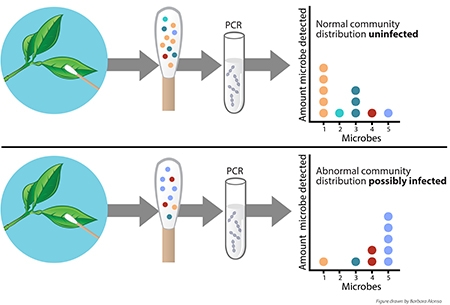Dr. Johan Leveau, a Professor of Plant Pathology at UC Davis, is comparing the differences between healthy citrus trees and citrus trees infected with the bacterium Candidatus Liberibacter asiaticus (CLas), that causes Huanglongbing disease (HLB). The most obvious difference is the presence of CLas DNA in infected plants. Polymerase Chain Reaction (PCR) is a test that can detect CLas DNA and is currently the only way to confirm the presence of the bacterium in trees.
However, for PCR-based methods to work, the bacterium must be present in the plant tissue tested and the chance of sampling a leaf that has the bacterium is low when the tree is in the early stages of infection. There is much interest in developing an alternative method of CLas detection using methods that take advantage of the tree-wide changes that occur upon initial infection. Dr. Leveau's research has discovered that microbial communities living on the surface of citrus tree leaves change during CLas infection. Leveau's team collects microbes from foliage by swabbing leaves, uses DNA-based methods to profile the bacteria and fungi that are present on the swab sample, and compares the profiles of CLas -infected and uninfected trees. If successful, this method would reduce the cost of sampling for CLas, greatly increase the number of trees sampled, and help tree removal get ahead of the disease epidemic.
Download the Research Snapshot to learn more, and visit our Research Snapshots page.
About Research Snapshots
We have developed short, descriptions of research projects that aim to help in the fight against HLB. These projects include traditional breeding and genetic engineering to create resistant citrus varieties, psyllid modification, using other organisms to deliver HLB-resistance genes, and early detection of the bacterium in trees.

